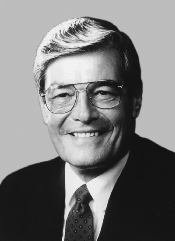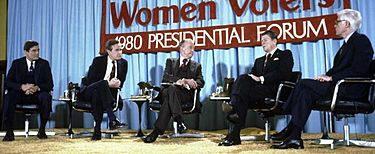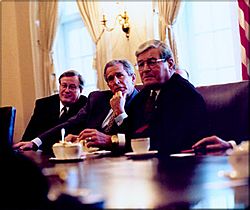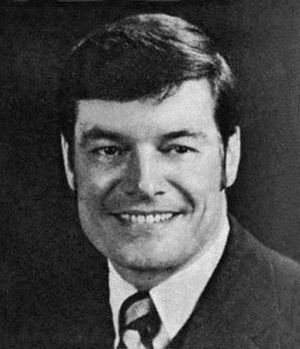Phil Crane facts for kids
Quick facts for kids
Phil Crane
|
|
|---|---|
 |
|
| Chair of the Republican Study Committee | |
| In office 1973–1989 |
|
| Preceded by | Position established |
| Succeeded by | Dan Burton |
| Member of the U.S. House of Representatives from Illinois |
|
| In office November 25, 1969 – January 3, 2005 |
|
| Preceded by | Donald Rumsfeld |
| Succeeded by | Melissa Bean |
| Constituency | 13th district (1969–1973) 12th district (1973–1993) 8th district (1993–2005) |
| Personal details | |
| Born |
Philip Miller Crane
November 3, 1930 Chicago, Illinois, U.S. |
| Died | November 8, 2014 (aged 84) Jefferson, Maryland, U.S. |
| Political party | Republican |
| Spouse | Arlene Johnson |
| Children | 7 |
| Relatives | Dan Crane (brother) |
| Education | DePauw University University of Michigan, Ann Arbor Hillsdale College (BA) Indiana University, Bloomington (MA, PhD) |
Philip Miller Crane (born November 3, 1930 – died November 8, 2014) was an American politician. He was a member of the Republican party. He served in the United States House of Representatives from 1969 to 2005. He represented the 8th District of Illinois, which includes the northwestern suburbs of Chicago. When he lost his election in 2004, Phil Crane was the Republican who had served the longest in the House of Representatives.
Contents
Early Life and Education
Phil Crane was born in Chicago, Illinois. His parents were Cora Ellen and George Washington Crane III. His father was a doctor and a college professor.
Crane went to several colleges. These included Hillsdale College, the University of Vienna, and Indiana University. He earned a PhD in history from Indiana University in 1961. He also studied at DePauw University and the University of Michigan.
After college, Crane served in the United States Army. He also taught at Indiana University and Bradley University. He worked for the Republican National Committee. He was a research director for Barry Goldwater's presidential campaign in 1964.
Phil Crane had two brothers who were also involved in politics. His brother Dan Crane served in Congress from Illinois. Another brother, David Crane, ran for Congress in Indiana. People sometimes called them "the Kennedys of the Right" because of their political involvement.
Political Career
Phil Crane was first elected to the United States Congress in 1969. This was a special election for the 13th District. He took the place of Donald Rumsfeld, who moved to a new job. Crane was a very conservative candidate. He won the special election with 58 percent of the votes.
He quickly became known as one of the most conservative members of the House. He was part of a group of congressmen who were inspired by Barry Goldwater. Crane was reelected 16 times. His district number changed over the years. It went from the 13th, to the 12th, and then to the 8th. His district was considered very Republican. He often won with 70 percent or more of the votes.
In 1970, Crane helped start a group called the Republican Study Committee. This group was made up of conservative congressmen. Their goal was to keep an eye on the Republican leaders. Crane was the first chairman of this group. He stayed a member of the group throughout his time in Congress.
In 1974, Crane helped with an important event. He was part of the first public audit of the United States Bullion Depository at Fort Knox. This audit was filmed. Twelve congressmen and 100 journalists were there.
In 1976, he led the Illinois Citizens for Ronald Reagan. He gave many speeches for Reagan's presidential campaign. Reagan was a conservative governor from California.
From 1977 to 1979, Crane was the chairman of the American Conservative Union (ACU). This group works to promote conservative ideas. During his time, the ACU worked against President Jimmy Carter's plan to give control of the Panama Canal to Panama. They also opposed a treaty with the USSR about limiting weapons.
1980 Presidential Campaign

In 1978, Phil Crane announced he would run for president in 1980. He was seeking the Republican nomination. Many people were surprised because he had supported Ronald Reagan before. Crane thought Reagan might not run again. However, Reagan did run, and Crane stayed in the race. He was one of the first candidates to drop out during the Republican primary elections.
Later Political Career
After the 1980 campaign, Crane's influence in Congress changed. Other conservative leaders, like Newt Gingrich, became more prominent. By 1994, when Republicans gained control of the House, Crane was seen as a supporter of Republican goals.
Crane was an important member of the House Ways and Means Committee. This committee deals with tax issues. He led its trade subcommittee. He worked hard to promote his strong belief in free trade. This means allowing goods to move between countries without many taxes or rules.

When the committee's chairman retired in 2000, Crane wanted to become the new chairman. He had been on the committee since 1975, making him the most senior member. However, Bill Thomas of California was chosen instead. Crane did become the vice-chairman of the committee.
Crane also played a role in ending the ban on chewing gum in Singapore. This happened during talks for a trade agreement between the U.S. and Singapore.
Political Defeat
In 2002, Phil Crane's opponent was a Democrat named Melissa Bean. She said that Crane was not connected with the people he represented. Some Republican voters also felt they had not seen him much. Bean did not have much money for her campaign. But she still got 43 percent of the votes. This was a surprise to many.
Bean ran against Crane again in the 2004 election. Crane seemed less excited about campaigning. People thought he might retire soon. Bean was seen as a moderate Democrat. This made the election for this Republican seat very close. Bean raised almost as much money as Crane. Most of her money came from small donations. Crane received most of his money from special interest groups.
Melissa Bean defeated Phil Crane by about four percentage points. This happened even though George W. Bush won the district in the 2004 presidential election. Since then, the 8th district has mostly been represented by Democrats.
Death
Phil Crane died from lung cancer on November 8, 2014. He passed away at his daughter Rebekah's home in Jefferson, Maryland. He was 84 years old, and his death was five days after his birthday.


